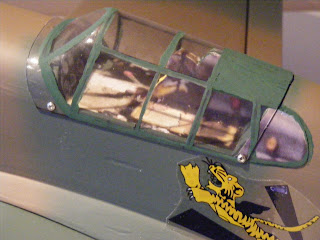We are all not capable of replicating the intricate details of full scale subjects in miniature although we look up to those who can. Most of us wouldn't spend the time and effort required to produce a high quality detailed scale model aircraft even even if we could. What we really want is a flying scale model that looks right from 10 or 15 feet distance. There is an easy way to get the results that you are looking for. With only a minimal effort one can produce a good looking model like the one below from a Ho-Hum ARF like the one pictured below it.
The method I have been using lately utilizes images from the internet, an image editing program, a color printer and some reasonable quality photographic paper. The photographic paper is required just to conserve the color ink, which seems to be the only expensive item used in the process.
The following images were quickly located via Google Images and the scale accuracy is unquestionable since they are of full scale aircraft.
The first problem with using the downloaded images to decorate the P40 model to find an identical mirror image to apply to the opposite side. After some thought the solution was to utilize the editing software's photo flipping about an axis procedure. Flipping photos 3 and 4 about the x axis gives identical mirror images for applying to the right hand side of the model's fuselage.
The second problem was to print images of an appropriate model scale Again the solution was quite simple, this time we resorted to using the print preview process. This process allows the user to resize the object and shows the resized object over the paper sheet. Since the size of the paper sheet (dps) is known as is the appropriate model dimension (dm). The apparent screen dimension of paper can be scaled from the computer screen. (adps). There is now one unknown, the apparent object dimension which we will call "x".
Then utilizing the rule of ratios.
(x)/(dm)= (adps)/(dps) or (x)=(adps)(dm)/(dps)
Resizing the object on the screen to dimension "X" will give the appropriate size after printing.
The following are some closeups of the model after applying the images.
The instrument panel, exhaust ports and cockpit were first cut out from the printed photographs and applied to the model with CA glue.
The pilot figure and turtle deck was cut from the photographs and glued to both sides of foam core poster board with canopy glue, CA would work just as well. After drying the poster board was cut to the correct profile and glued on the cockpit centerline with white glue.
The canopy glazing frames were painted to the inside of the canopy to minimize wearing off from handling. If this were a nitro powered model the items would need to be fuel proofed by spraying with clear paint. The wire landing gear struts were thickened up to resemble oleos by slipping silver painted sections of soda straws over the thin music wire
Model Specifications:-
Aircraft Type Curtis P40 War Hawk
Wing Span 34 inches
Flying Weight 1 pound
Power Speed 400 Brush-less Out Runner
Servos 3 9 g
Control Rudder, Elevator and Ailerons
Battery 800 ma 3 cell Li Po
Controller ESC 30 amp









No comments:
Post a Comment